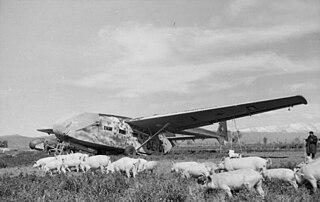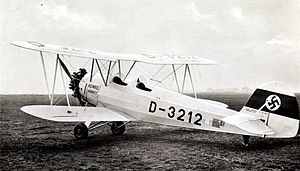
The Focke-Wulf Fw 44 is a 1930s German two-seat biplane known as the Stieglitz ("Goldfinch"). It was produced by the Focke-Wulf company as a pilot training and sport flying aircraft. It was also eventually built under license in several other countries.

The Focke-Wulf Fw 187 Falke ("Falcon") was a German aircraft developed in the late 1930s. It was conceived by Kurt Tank as a twin-engine, high-performance fighter, but the Luftwaffe saw no role for the design, perceiving it as intermediate between the Messerschmitt Bf 109 and Bf 110. Later prototypes were adapted to two-seats to compete with the Bf 110 in the Zerstörer role, but only nine aircraft were built in total.

The Focke-Wulf Fw 58 Weihe ("Harrier") was a German aircraft, built to fill a request by the Luftwaffe for a multi-role aircraft, to be used as an advanced trainer for pilots, gunners and radio operators.

The Focke-Wulf Fw 189 Uhu is a German twin-engine, twin-boom, three-seat tactical reconnaissance and army cooperation aircraft. It first flew in 1938, entered service in 1940 and was produced until mid-1944.

The Messerschmitt Bf 108 Taifun was a German single-engine sport and touring aircraft, developed by Bayerische Flugzeugwerke in the 1930s. The Bf 108 was of all-metal construction.

The Gotha Go 242 was a transport glider used by the Luftwaffe during World War II. It was an upgrade over the DFS 230 in both cargo/troop capacity and flight characteristics. Though it saw limited action, it appeared in multiple variants.

The Heinkel He 118 was a prototype German monoplane dive bomber design that lost out to the Junkers Ju 87 Stuka in the 1930s, and was never ordered by the Luftwaffe.
The Flettner 184 was a German night reconnaissance and anti-submarine autogyro developed during the 1930s.

The Henschel Hs 130 was a German high-altitude reconnaissance and bomber aircraft developed in World War II. It suffered from various mechanical faults and was never used operationally, only existing as prototype airframes.
The Dornier Do 317 was a prototype German medium bomber of World War II.

The Heinkel Lerche was the name of a set of project studies made by German aircraft designer Heinkel in 1944 and 1945 for a revolutionary VTOL fighter and ground-attack aircraft.

The Focke-Wulf Fw 56 Stösser was a single-engine, parasol monoplane advanced trainer, built in the 1930s in Germany.

The Heinkel HD 42 50, later designated the Heinkel He 42 was a German two-seat biplane seaplane originally designed for the Deutsche Verkehrsfliegerschule, and later built for the German Luftwaffe. The aircraft was used until the end of World War II as a trainer for maritime pilots.

The Heinkel He 49 was a German single-bay, single-seat biplane of mixed construction armed with two machine guns. Four variants were made, the He 49a, He 49b, He 49c.
The Bücker Bü 134 was a German single engine, high wing cabin monoplane prototype designed and built by Bücker Flugzeugbau GmbH.

The Siebel Fh 104 Hallore was a small German twin-engined transport, communications and liaison aircraft built by Siebel.

The Heinkel He P.1079 was a projected German V-tail all weather jet fighter designed by Heinkel Flugzeugwerke in the closing stages of World War II. The aircraft was only a design; it was not produced.

The Arado Ar 77 was a German twin-engined monoplane, designed as an advanced training aircraft from 1934.
The Focke-Wulf Fw 238 was a four-engine low wing strategic bomber developed by the German aeronautical company Focke-Wulf-Flugzeugbau AG in the early 1940s and remained at the project stage. Designed to the same specifications issued by the Reichsluftfahrtministerium (RLM) which led to the Focke-Wulf Ta 400 and Junkers Ju 390, its development was cancelled by the RLM.
The Gotha Go 241 was a low-wing twin-engined four-seat transport aircraft manufactured by Gothaer Waggonfabrik in the early 1940s and intended for the general aviation market.















